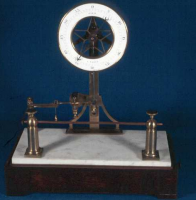








A pyrometer is a type of thermometer used to measure high temperatures. Various forms of pyrometers have historically existed. In the modern usage, it is a non-contacting device that intercepts and measures thermal radiation, a process known as pyrometry. The thermal radiation can be used to determine the temperature of an object's surface.
Principle of operation
A modern pyrometer has an optical system and a detector. The optical system focuses the thermal radiation onto the detector. The output signal of the detector (temperature T) is related to the thermal radiation or irradiance j* of the target object through the Stefan–Boltzmann law, the constant of proportionality ?, called the Stefan-Boltzmann constant and the emissivity ? of the object.
This output is used to infer the object's temperature. Thus, there is no need for direct contact between the pyrometer and the object, as there is with thermocouples and resistance temperature detectors (RTDs).
History
The potter Josiah Wedgwood invented the first pyrometer to measure the temperature in his kilns,which first compared the color of clay fired at known temperatures, but was eventually upgraded to measuring the shrinkage of pieces of clay, which depended on the heat of the kiln.Later examples used the expansion of a metal bar.
Modern pyrometers became available when the first disappearing filament pyrometer was built by L. Holborn and F. Kurlbaum in 1901.This device superimposed a thin, heated filament over the object to be measured and relied on the operator’s eye to detect when the filament vanished.The object temperature was then read from a scale on the pyrometer.
The temperature returned by the vanishing filament pyrometer and others of its kind, called brightness pyrometers, is dependent on the emissivity of the object. With greater use of brightness pyrometers, it became obvious that problems existed with relying on knowledge of the value of emissivity. Emissivity was found to change, often drastically, with surface roughness, bulk and surface composition, and even the temperature itself.
To get around these difficulties, the ratio or two-color pyrometer was developed. They rely on the fact that Planck's law, which relates temperature to the intensity of radiation emitted at individual wavelengths, can be solved for temperature if Planck's statement of the intensities at two different wavelengths is divided. This solution assumes that the emissivity is the same at both wavelengths and cancels out in the division. This is known as the gray body assumption. Ratio pyrometers are essentially two brightness pyrometers in a single instrument. The operational principles of the ratio pyrometers were developed in the 1920s and 1930s, and they were commercially available in 1939.
As the ratio pyrometer came into popular use, it was determined that many materials, of which metals are an example, do not have the same emissivity at two wavelengths.For these materials, the emissivity does not cancel out and the temperature measurement is in error. The amount of error depends on the emissivities and the wavelengths where the measurements are taken.Two-color ratio pyrometers cannot measure whether a material’s emissivity is wavelength dependent.
To more accurately measure the temperature of real objects with unknown or changing emissivities, multiwavelength pyrometers were envisioned at the US National Institute of Standards and Technology and described in 1992.Multiwavelength pyrometers use three or more wavelengths and mathematical manipulation of the results to attempt to achieve accurate temperature measurement even when the emissivity is unknown, changing, and different at all wavelengths.